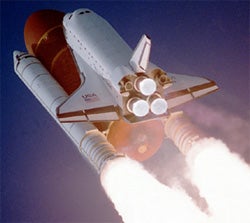First, a shuttle must launch to achieve the desired orbit orientation. Nowadays, this is the orbital plane of the International Space Station (ISS), which is inclined 51.6° to Earth’s equator. Because the launch pad can’t pivot to the needed angle before liftoff, a shuttle must rotate after launch to adjust. Then the vehicle, which initially moves slightly faster than ISS because it starts off in a lower orbit, can “catch up” to the station and dock with it.
Second, about a minute after liftoff, all atmospheric forces on the vehicle reach their peaks. Rotating a shuttle right after launch puts the vehicle into a position that helps reduce stress on the orbiter, especially on the wings and tail.
Finally, the roll maneuver enables a shuttle’s pilot to see the horizon. This provides an important reference in the event controllers need to abort a mission during launch. — Bill Cooke, NASA’s Marshall Space Flight Center, Huntsville, Alabama










